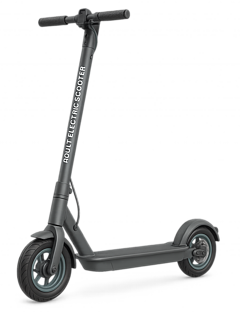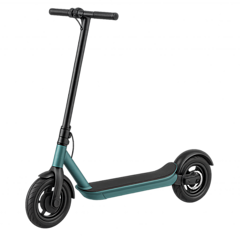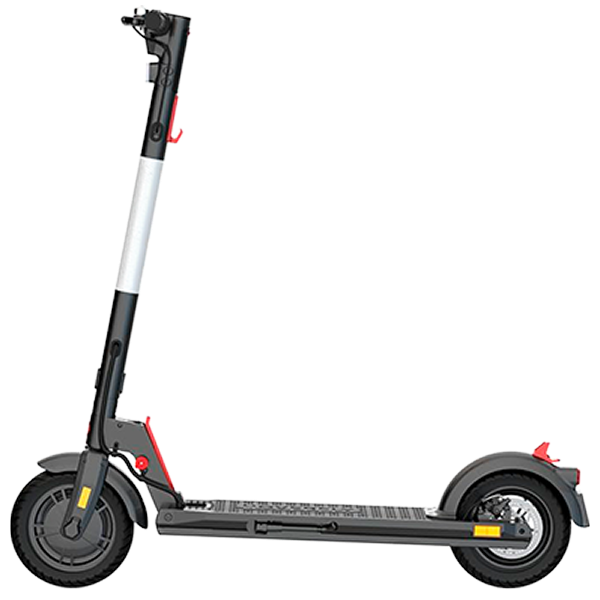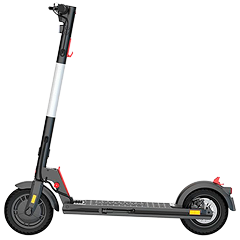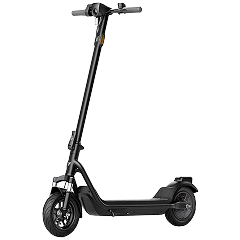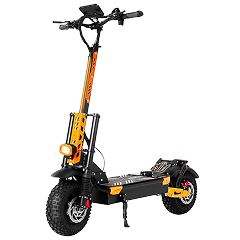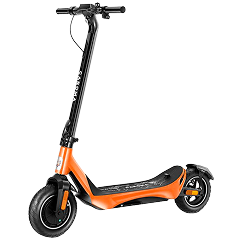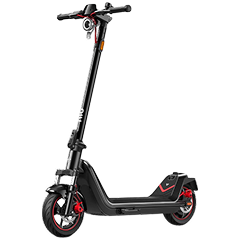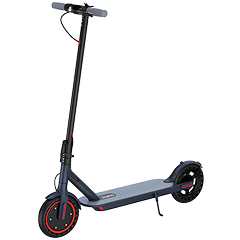Kids’ electric scooters occupy a unique space in the personal mobility world. They need to be engaging enough to hold a child’s attention, safe enough that parents don’t worry, and durable enough to survive the inevitable crashes, drops, and “let me see what happens if I ride this down the stairs” experiments.
The stakes feel higher with electric scooters for kids because you’re not just buying a product, you’re making decisions about your child’s safety and independence. Get it wrong, and you’ve either got a bored kid with an underpowered toy or a terrified parent with a speed demon on wheels.
The good news is that kids’ electric scooters have evolved significantly. Manufacturers have learned that parents make the purchasing decisions, which means safety features, age-appropriate performance, and parental controls have become standard rather than afterthoughts.
Understanding Age-Appropriate Performance
Kids’ electric scooters are smaller versions of adult models, designed around the developmental stages of childhood, with performance limits that match coordination, reaction times, and judgment capabilities at different ages.
Age-Appropriate Specifications at a Glance
These are the specs at a glance:
Detailed Age Group Considerations
Early Elementary (6-8 Years)
Scooters for this age group will max out around 6-8 mph, which sounds slow until you remember that most adults jog at about 6 mph. For a small child, 8 mph feels genuinely fast while remaining manageable if something goes wrong.
Motors in this category are often under 150W, providing just enough acceleration without the jarring takeoff that can throw a young rider off balance. Battery capacities are modest, around 65-100 Wh, yielding 3-5 miles of range or 40-60 minutes of runtime. This matches both the attention span and physical endurance of younger children.
Weight limits for this age group hover around 130-150 pounds, which provides plenty of growth room while ensuring the scooter performs as designed. The focus is on lightweight construction, simple controls, and safety features like kick-to-start technology that prevents accidental acceleration.
Middle Elementary (9-10 Years)
The 9-10 age bracket represents a sweet spot where kids have developed better balance and coordination but still benefit from protective limitations. Scooters for this group typically reach 8-10 mph, with motors in the 100-250W range.
Battery capacities increase to 100-150 Wh, supporting longer adventures with 4-7 miles of range or 50-70 minutes of runtime while still requiring regular charging that gives parents natural break points. This provides enough time for neighborhood exploration without disappearing for hours.
This age group often sees the introduction of dual speed modes, allowing kids to start conservatively and work up to full performance as their skills develop. Electronic braking becomes more sophisticated, often paired with rear foot brakes for redundancy.
Tweens (11-12 Years)
Eleven and twelve-year-olds can handle more sophisticated scooters with speeds reaching 10-12 mph. Motor power increases to 200-350W, providing better hill climbing and acceleration while maintaining safety margins.
Battery capacities of 150-250 Wh become common, supporting ranges of 6-10 miles or 60-90 minutes of runtime. This matches the increased independence and longer attention spans of tweens while still providing manageable charging schedules.
Features like LED displays, cruise control, and smartphone apps start appearing in this category. The scooters begin resembling adult models in capability while maintaining age-appropriate safety features.
Safety Features That Matter For Young Riders
Wearing helmets when riding scooters should be a hard rule for the kids’ safety. However, electric scooters for kids also need built-in protections that account for developing motor skills, questionable judgment, and the tendency to push boundaries.
Kick-to-Start Technology
Perhaps the most important safety innovation in kids’ scooters is kick-to-start technology. This prevents the scooter from taking off while a child is still getting positioned, mounting, or adjusting their stance.
The system requires the rider to push off with their foot to get the scooter moving before the motor engages. This simple feature eliminates the startling jerk of unexpected acceleration and gives kids time to get settled before power kicks in.
Some advanced systems use multiple sensors, requiring both foot pressure on the deck and detection of forward motion before engaging the motor. If the rider lifts their foot or stops moving, power cuts immediately.
Speed Management and Parental Controls
Modern kids’ scooters often feature multiple speed modes, allowing gradual progression as skills develop. A typical setup might offer 6 mph, 8 mph, and 10 mph modes, letting parents control maximum performance.
Advanced models include smartphone apps that allow parents to set speed limits remotely, monitor ride locations, and even set time-based restrictions. Some systems send alerts when the scooter exceeds set boundaries or speed limits.
However, remember that speed limiting technology is only as good as your child’s willingness to respect it. Tech-savvy kids can sometimes find workarounds, making clear communication about expectations just as important as the technology itself.
Braking Systems for Young Riders
Kids’ scooters typically use simpler braking systems than adult models, but they need to be more intuitive and fail-safe. The most common setup combines electronic regenerative braking with a rear foot brake.
Electronic braking engages automatically when the throttle is released, providing smooth, predictable deceleration. This works well for kids because it doesn’t require additional input or coordination; it just stops when they stop accelerating.
Rear foot brakes, operated by stepping on the rear fender, provide emergency stopping power and work even if the electronic system fails. They’re intuitive for kids coming from traditional kick scooters and provide a backup that doesn’t rely on battery power.
Hand-operated brake levers are less common on younger kids’ scooters because they require additional coordination and finger strength. When present, they’re usually paired with other braking methods rather than serving as the primary system.
Lighting and Visibility
Many kids’ scooters come with elaborate LED light systems that serve both safety and entertainment purposes. Visibility is important because kids are naturally less predictable than adult riders. They’re more likely to make sudden direction changes, stop unexpectedly, or ride in areas where they’re hard to see.
Build Quality and Durability Considerations
Kids are harder on equipment than adults. They don’t consciously abuse their scooters, but they lack the experience to recognize what might damage them. A kids’ electric scooter needs to survive drops, crashes, curb impacts, and the occasional attempt to jump something inadvisable.
Frame Construction and Materials
Most electric scooters for kids use aluminum alloy construction similar to adult models, but with different priorities. Adult scooters optimize for weight or performance, while kids’ models focus on impact resistance and abuse tolerance.
Look for frames with smooth, consistent welds and minimal sharp edges. The connection points between the deck, stem, and handlebars receive the most stress and should show signs of reinforcement or thicker material.
Plastic components should be limited to non-structural elements like fender covers or decorative pieces, while weight-bearing parts like the folding mechanism, brake systems, and wheel mountings should be metal construction.
Folding Mechanisms
Kids’ scooters usually feature simplified folding mechanisms compared to adult models. This isn’t a compromise, but a recognition that complex mechanisms are more likely to be operated incorrectly or damaged by inexperienced users.
The best kids’ scooter folding systems use large, obvious levers or latches that clearly show whether they’re properly engaged. Avoid mechanisms with small, fiddly parts or unclear positioning, these tend to break or be operated incorrectly.
However, many kids’ scooters skip folding entirely, prioritizing durability and simplicity over portability. This can be the right choice if the scooter will be stored in a garage or used primarily in one location.
Wheel and Tire Considerations
Most kids’ scooters use solid rubber tires rather than pneumatic (air-filled) tires, prioritizing low maintenance over ride quality. This makes sense for young riders who might not notice if their tires need air.
Solid tires eliminate the possibility of flats, reduce maintenance requirements, and provide consistent performance regardless of air pressure. The trade-off is a harsher ride over bumps and less traction, especially on wet surfaces.
Wheel size typically ranges from below 4 inches on the smallest models to about 9 inches on teen-oriented scooters. Larger wheels provide better bump handling and stability, while smaller wheels keep the overall scooter size manageable for young riders.
Motor
Kids’ scooter motors face different challenges than adult models. Rather than sustained high-power operation, they see frequent start-stop cycles, extended periods of maximum throttle, and operation by riders who don’t understand concepts like motor cooling or battery preservation.
Look for scooters with conservative motor ratings relative to their performance. A motor rated for 200W continuous power running at 150W most of the time will last longer than one constantly operating at its limit.
Weight Limits and Sizing
Kids’ scooter weight limits require more careful consideration than adult models because children grow so quickly. An electric scooter for kids that fits perfectly today might be outgrown in six months, while one sized for future growth might be unwieldy for current use.
Planning for Growth
Most kids’ scooters have weight limits between 110-180 pounds (with some outliers crossing into the ‘adult’ 220 lbs territory), which provides reasonable growth room for most age groups. However, consider both your child’s current weight and their likely weight in 2-3 years when making your choice.
A 10-year-old weighing 80 pounds might seem like they have plenty of room on a 110-pound-capacity scooter, but they could easily reach 120 pounds by age 13. Planning for growth helps maximize the useful life of the scooter.
However, don’t oversize dramatically. A scooter designed for a 150-pound rider might feel unstable or hard to control for a 70-pound child. The best approach is usually to size for 2-3 years of growth rather than trying to buy once for their entire childhood.
Handlebar Height and Adjustability
Adjustable handlebars are one of the most valuable features on a kids’ scooter because they allow the scooter to grow with the child. Height adjustments on kids electric scooters often range from 20-35 inches, covering most children from age 6 through their early teens.
When handlebars are properly adjusted, they should reach somewhere between the child’s waist and chest while standing naturally on the deck. Too low forces hunching, while too high creates awkward arm positioning and reduced control.
Some scooters use telescoping stems with multiple adjustment points, while others have fixed positions with removable spacers or pins. Telescoping systems offer more precise adjustment but can develop play or looseness over time.
Here’s a handlebar height recommendation table by age:
Deck Size and Stance
Kids’ scooter decks are usually smaller than adult models, but they still need adequate space for comfortable foot placement and growth. A deck around 17-20 inches long by 5-8 inches wide works for most kids, though larger children benefit from adult-sized dimensions.
The deck surface should provide secure footing with grip tape, textured material, or molded non-slip patterns. Kids are more likely than adults to wear soft-soled shoes or sneakers that need extra grip to maintain control.
Consider deck height as well as surface area. Lower decks provide better stability and easier mounting/dismounting for younger children.
Battery Performance and Charging
Kids’ scooter batteries face unique challenges compared to adult models. Young riders tend to use full throttle constantly, drain batteries completely, and forget to charge them regularly. The battery system needs to handle this abuse while maintaining safety.
Capacity vs Range Reality
Manufacturer range claims for kids’ scooters are often even more optimistic than adult models because they assume conservative riding patterns that don’t match how children actually use scooters.
A scooter advertised with 6 miles of range might deliver 4-5 miles with an adult riding conservatively, but only 3-4 miles with a kid using full throttle constantly. Plan accordingly when evaluating whether the range meets your needs.
Battery capacity typically ranges from 65 Wh in entry-level models to 250+ Wh in tween-oriented scooters. As a rough guide, expect about 15-20 Wh per mile of real-world range with typical kid riding patterns, or about 40-60 minutes of runtime for smaller batteries and 60-90 minutes for larger ones.
Charging Safety and Convenience
Kids’ scooters should include charging systems with multiple safety features because young riders are unlikely to follow optimal charging practices. Look for automatic shutoff when fully charged, temperature monitoring, and protection against overcharging.
Charging times usually range from 2-5 hours, depending on battery size. Some electric scooters for kids include removable batteries, which can be helpful for families without convenient outdoor charging locations. However, removable batteries add complexity and potential points of failure.
Battery Life and Replacement
Kids’ scooter batteries will usually last 2-4 years with regular use, depending on charging habits and usage patterns. Unlike adult scooters, where battery replacement might be economically questionable, kids’ models are often worth repairing because they’re likely to be passed down or shared.
Battery replacement costs can range from $30-$100, depending on the scooter and battery size.
Performance vs Safety Trade-offs
Every aspect of a kids’ scooter involves balancing performance with safety considerations. Understanding these trade-offs helps you make informed decisions about what’s appropriate for your specific child and situation.
Speed Limitations
The most obvious performance limitation is speed. Young riders haven’t developed the reaction times, spatial awareness, or judgment to handle high speeds safely.
A 12-year-old might technically be capable of controlling a 20 mph scooter in ideal conditions, but they lack the experience to recognize when conditions aren’t ideal. Speed limits provide safety margins for the unexpected situations that experienced riders learn to anticipate.
However, overly conservative speed limits can backfire by making the scooter boring. A 10-year-old riding a 6 mph scooter might abandon it for a regular kick scooter that lets them go faster downhill. Find the balance between safety and engagement.
I would recommend capping the speed at 15 mph for kids.
Power and Acceleration
Motor power affects top speed and acceleration characteristics. More powerful motors provide snappier acceleration, which can be fun but also challenging for developing riders to control smoothly.
Kids’ scooters often use lower-powered motors than their specifications might suggest they need. A 200W motor might seem underpowered for a scooter that weighs 25 pounds plus a 80-pound rider, but the moderate acceleration helps maintain control.
Gradual acceleration also reduces stress on the rider, the scooter, and the battery. Kids can focus on steering and balance without fighting sudden power delivery that might throw them off balance.
Here’s a motor power and acceleration recommendation table by age:
Maintenance and Longevity
Kids’ electric scooters need to be designed for minimal maintenance because young riders won’t perform regular upkeep. The best electric scooters for kids work reliably with basic care and survive neglect better than adult models.
Low-Maintenance Design
Most kids’ electric scooters use solid tires specifically to eliminate the most common maintenance task: checking and adding air pressure. Yes, this compromises ride quality, but it also eliminates a frequent cause of parental frustration and unsafe riding.
Braking systems in kids’ scooters favor drum brakes or electronic systems over disc brakes because they require less adjustment and maintenance. Mechanical disc brakes can provide better stopping power, but they need regular adjustment as pads wear.
Chain drives are almost never (well, more recently) seen on kids’ scooters because they require regular lubrication, adjustment, and replacement. Hub motors eliminate these maintenance requirements while providing adequate performance.
Durability and Abuse Tolerance
Kids don’t consciously abuse their scooters, but they subject them to impacts and stresses that adult riders avoid. Curb impacts, drops, crashes into obstacles, and attempts to jump or perform tricks are normal parts of kids ownership.
Look for electric scooters for kids with robust mounting points for wheels, handlebars, and other components. These areas see the highest stress and are most likely to fail after repeated impacts.
Plastic components should be replaceable wear items rather than structural elements. Fender covers, grip materials, and decorative pieces can be plastic, but avoid plastic wheel mounts, steering components, or folding mechanisms.
Repairability and Parts Availability
Consider parts availability when choosing a brand and model. Established manufacturers typically offer replacement parts for several years after discontinuing models, while unknown brands might disappear entirely.
Basic maintenance items like brake pads, grips, and tires should be readily available and reasonably priced. More complex repairs like motor or battery replacement might not be economical, but they shouldn’t be needed during the normal lifespan of the scooter.
Technology and Connectivity
Modern kids’ scooters increasingly include smartphone apps, GPS tracking, and connectivity features that can enhance safety and convenience, though they add complexity and potential failure points.
Smartphone apps typically offer speed limiting, location tracking, and usage monitoring for valuable parental peace of mind. However, technology is a tool, not a substitute for clear communication and appropriate supervision. The most sophisticated monitoring won’t prevent problems if kids don’t understand the rules. Also,discuss tracking openly with older children rather than implementing it secretly
Legal and Regulatory Considerations
Laws around kids riding electric scooters are all over the map, so you’ll need to do some homework before your child hits the pavement. Keep this in mind:
- Most places set minimum ages somewhere between 8-16 years old, and many require adult supervision for younger kids.
- Helmet laws vary wildly too, where some areas mandate them for everyone, others just for children, and a few don’t require them at all (though you should use one regardless).
- Speed limits usually apply to everyone, but enforcement tends to be more lenient with kids.
The bigger challenge, however, is figuring out where your child can actually ride. Many areas ban scooters from sidewalks entirely, which can be frustrating when you’re trying to keep kids safe from traffic.
School policies are also quite important if you’re considering scooter commuting. Some schools welcome them, others ban them outright, and many fall somewhere in between with specific storage or timing requirements. And parks and recreational areas often have their own rules that might differ from city regulations.
Therefore, spend 15 minutes researching your local rules before spending hundreds on a kids electric scooter. It beats discovering after the fact that your new purchase can’t be used where you planned.
In a Nutshell: What Should You Consider When Buying Your Kid an Electric Scooter?
Above all else, the key to getting the right scooter is matching your child’s individual maturity and development stage rather than just following age guidelines. However, kids of a similar age tend to possess similar characteristics, and this rough guide can help you find a starting point.
6-8 Years (Foundation Building)
9-10 Years (Skill Development)
11-12 Years (Growing Independence)
Universal Specifications (All Ages)
FAQs
What Age can a Child Start Using an Electric Scooter?
How Fast Should a Kids’ Electric Scooter Go?
These are (recommended) age-appropriate speeds:
- 6-8 years under 8 mph
- 9-10 years 8-10 mph
- 11-12 years 10-12 mph
Remember that 8 mph feels fast to small children, so start conservatively and increase speed as skills develop.


